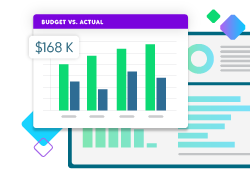7 Reasons to Integrate Your Fundraising CRM and General Ledger

Imagine this scene:
[FADE IN ON A BOARD MEETING]
DEVELOPMENT DIRECTOR: As of June 30, we’ve raised $9.2 million.
FINANCE DIRECTOR: Fiscal year-end numbers have not been fully reviewed yet, but recognized revenue from fundraising will be close to $7 million
DEVELOPMENT DIRECTOR: What?!?
EXECUTIVE DIRECTOR: Ugh.
[Executive Director throws head in hands. FADE OUT.]
Directors of Development and Directors of Finance often find themselves working in a love/hate relationship. Not with each other, typically, but rather with the key metrics they are each responsible for.
Development and Finance both love when fundraising reports and financial statements show increases over last year, over targets, and over budgets. Similarly, neither enjoys reporting that revenues are down. But even when fundraising is routinely exceeding targets and the gifts cannot be processed—nor the donors thanked—fast enough, Development and Finance both hate it when their numbers don’t match.
The Executive Director also hates it when the numbers don’t match, because ultimately, the buck stops with them.
Change the Scene with a Connected Fundraising and Fund Accounting System
Regardless of which team you’re on (and I’ve been on both), you want to love your numbers whether they’re up or down, knowing that you can confidently get them to reconcile with those of the other team.
And neither team wants to spend countless, unnecessary hours searching for reconciling items, or reformatting financial data generated by the fundraising system so that it can be pushed into the finance system without exceptions.
You can change the scenario—including the dramatic scene above—by effectively integrating data from your fundraising CRM and your accounting system. Incorporating technology solutions that act as bridges between your systems can ensure that nobody on either team is required to format transactions, add or delete rows or columns, or convert files to a different format.
So, let’s look at the top seven reasons to integrate your fundraising CRM with your general ledger:
- Reducing Errors
- Reducing Effort
- Maintaining Proper Control Over Data
- Reducing Clutter
- Easier Ongoing Reconciliation
- Common Understanding of ‘The Numbers’
- Promoting Collaboration Across Functions and Teams
1. Reducing Errors
When systems are integrated, you only need to enter data one time and in one place, whether manually keying or through an import. It follows then, that if transactions are only entered once, it cuts the opportunity for errors in half. If transactions are entered accurately the first time into an integrated system, there should be no concern about accuracy when they are posted, because no further human hand will touch them.
Even if your fundraising CRM generates a file to be imported into the accounting system, that output typically must be manually formatted by one team or both to ensure that it contains the proper columns, headers, and summarization. Plus, the fundraising output file often must be converted to another format before it can be brought into the accounting system. All of this presents the potential for errors.
Finally, integration can enforce some accounting internal controls that will further reduce the likelihood of errors. For example, an integrated posting process can mark transactions as ‘posted’ in the fundraising CRM so they can’t be inadvertently posted again. This locks a posted gift transaction so that it cannot be edited without generating adjusted journal entries.
2. Reducing Effort
Reducing effort means reducing the time, energy, and stress involved in getting fundraising financial data into the general ledger. There are several ways that integrating your systems can reduce effort overall:
- Entering data (manually or through an import) into only one system instead of into two systems reduces the overall amount of data entry, saving time.
- Not having to manipulate output files, manually summarize transactions, or convert files to another format will also reduce the time spent on the posting process and will make posting transactions from the fundraising CRM more efficient overall.
- When there are few or no errors, team members need to spend very little time on detective work, and the resulting corrective action. And your team can save even more time by not having to investigate and remediate hard-to-identify items that hinder reconciliation.
3. Maintaining Proper Control Over Data
One less obvious reason to integrate systems is to ensure that each team continues to maintain control over their own data—the data necessary to run their department of the organization.
When systems are integrated, each team can be confident that they don’t need to be over-involved in the other team’s work, or that the other team will need to be overly involved in theirs.
Development remains in charge of fundraising recording and reporting, while Finance continues to oversee accounting recording and reporting. But, with internal controls in place, everyone is confident that systems can easily align with each other.
4. Reducing Clutter
Reducing clutter goes to the concept of the integrated fundraising CRM serving as a true subsidiary ledger to the general ledger—the same way that Accounts Payable or Payroll is structured. In that case, most if not all fundraising transactional details remain in the fundraising system. From there, only summary transactions are posted from the CRM to the general ledger so that the latter does not become unnecessarily cluttered.
The caveat in this scenario is that it’s critical to ensure that the detail in the fundraising CRM always agrees with totals in the general ledger. At any time, a fundraising system report of transaction detail and totals by account or fund for a particular date (or date range) should always be able to tie to the corresponding account totals or balances in the general ledger for the same period.
5. Easier Ongoing Reconciliation
Everything discussed so far informs easier ongoing reconciliation between systems. As a standard rule-of-thumb, there should be a three-way-match between the fundraising system gift or revenue entry, the posting to the general ledger, and the deposit to the bank.
Integrated systems can ensure error-free and low-effort posting from the CRM to the general ledger corresponding to each bank deposit, whether that occurs daily, several times each week, or even several times each day. If every CRM gift batch can link back to what’s posted to the general ledger and to what’s deposited in the bank for that batch, end-of-period reconciliations should be a snap.
Even for non-depositable revenue—think pledges and gifts-in-kind—integrated systems make it easy to post and reconcile daily, or as often as is needed.
6. Common Understanding of ‘the Numbers’
In the dramatic scene at the beginning of this article, there was obviously no common understanding of the numbers between Development and Finance. Integrated systems force that common understanding because they support and encourage ongoing reconciliation—and common understanding when numbers don’t correspond.
In that scenario, the reason that the numbers were off was because some of the larger campaign pledges were conditional, and therefore not immediately recognizable as revenue. In addition, low-dollar one-time pledges were only recorded as revenue when they were paid, not pledged.
An integrated posting process and routine reconciliation would have not only identified these items on both sides, but also would have prompted proper internal communication to ensure that both teams reported consistently. Flexibility, efficiency, and accuracy are all key supporters of effective reconciliation, and internal communication is the pathway to ensure these three essential elements are top of mind.
Free download from the Blackbaud Institute: Your Guide to Creating a Cohesive Constituent Experience
7. Promoting Collaboration Across Functions and Team
Some of these top reasons for integrating systems are more tactical and others more strategic—or, perhaps, some quantitative and some qualitative. Long term, the qualitative cannot be ignored.
On the surface, integration resolves a tactical issue: accurately and efficiently getting revenue transactional data from the source system into the organization’s financial system of record. The outcome of successful integration is more time, less stress, and more confidence and trust, both in the process and in the numbers.
It goes back to that love/hate relationship. When you can consistently trust process and love the numbers, stronger cross-functional collaboration will naturally evolve. Team members will be happy to cooperate in the rare instances where something has to be investigated on one side or the other. Each will be inclined to be sure data are aligned and coordinated when communicating with executive or external stakeholders.
Integrated Systems and Better Transparency
Let’s see how that scenario would play out with an integrated fundraising CRM and general ledger.
[FADE IN ON A BOARD MEETING]
DEVELOPMENT DIRECTOR: As you can see, as of June 30, we’ve raised $6.9 million in cash and short-term pledges and another $2 million in conditional and long-term pledges. We’ve also recorded about $300,000 in smaller telemarketing pledges that, historically, we don’t count as gift revenue until they’re paid.
FINANCE DIRECTOR: That’s right. As you can see on the June 30 income statement, fundraising revenue for the year is just a hair over $6.9 million.
EXECUTIVE DIRECTOR: Thank you. Any questions from the Board?
[Executive Director smiles as a board member begins to make an innocuous statement – FADE OUT.]
Integrating your fundraising CRM and general ledger with purpose-built software will ensure that funds recorded as raised properly correspond with the money recorded as revenue from fundraising on financial statements—or reasonably explain when they don’t.
But along the way, you’ll save time, be more accurate, remove clutter, and build trust and confidence among the teams and their leadership. And, a fully aligned pair of integrated systems will drive improved transparency, insights, operations, and, ultimately, accountability to both leaders and donors for delivering your mission.
Ready to see an integrated CRM and fund accounting system in action? Check out our on-demand product tour with Blackbaud Raiser’s Edge NXT and Blackbaud Financial Edge NXT.
Fund Accounting Software that Drives Impact
Find out how Blackbaud’s Financial Edge NXT® fits your organization.


